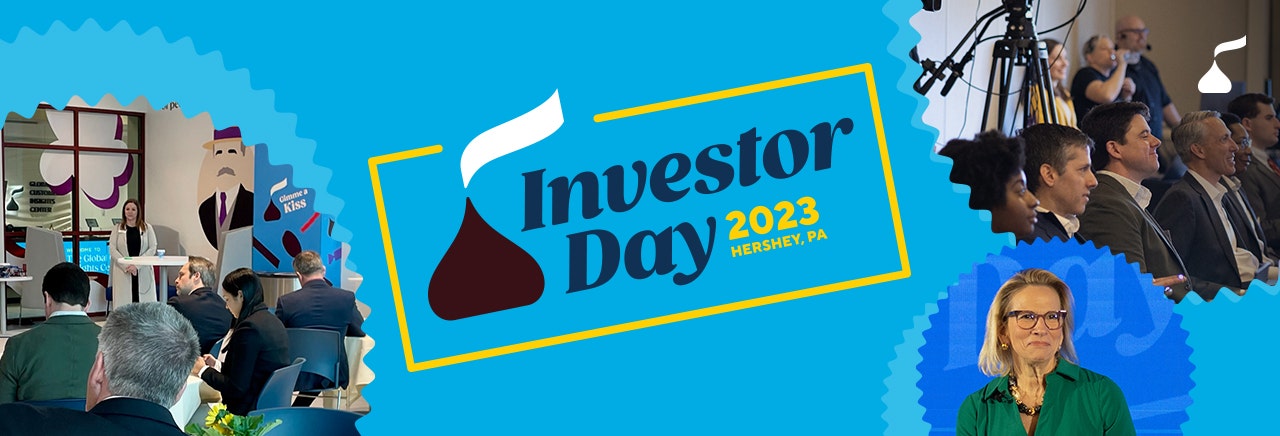Analysts Visit Hershey to Learn About What’s in Store
This spring, more than 60 analysts traveled to Hershey, Pennsylvania to learn about the company’s Leading Snacking Powerhouse vision and the strategies and investments to achieve its ambition. As a result of the pandemic, the company had not convened investors since Michele Buck's first day as President and CEO (March 1, 2017), and it’s the first time in more than 20 years that “Investor Day” was held at Hershey’s Pennsylvania headquarters.
In a conference room at The Hotel Hershey, President and CEO Michele Buck welcomed investors to the town where streetlights take the shape of Hershey's KISSES. She discussed the company’s strengths, including the iconic brands that consumers love, its team members who are committed to achieving excellence and its financial capacity to invest and deliver for shareholders.
“And importantly,” said Buck, “all of this is further fueled by a mindset of never being satisfied, not resting on our laurels, a restless ambition to be the best, to constantly look back and figure out how we can elevate and transform, to plan for the future while delivering today.”
Managing growth
Following Buck’s welcome, Hershey leaders shared insights about the business, starting with Chuck Raup, President of Hershey’s U.S. confection business. Raup explained how Hershey works to understand consumer trends that fuel brand growth. Through the pandemic, for example, more consumers have been eating chocolate and candy at home. At first, that was for personal safety reasons. Now, he says, people are more focused on mental and physical wellness. “When people are looking to take a break from a very tough world, they turn to chocolate, which is a great thing,” said Raup.
For physical well-being, he says, more consumers are looking for better-for-you snacks. Hershey has been delivering there, as well, with the THiNS line, including the Kit Kat® and Reese’s brands, and with its reduced sugar portfolio, which has been well received. “We've rebranded our sugar-free items (including Reese’s, Hershey’s and York) to Zero Sugar, and we've seen tremendous growth; we've doubled our business since we've done that,” says Raup. In addition, Raup said the company is seeing a lot of momentum for gummies and has expanded its portfolio to include Jolly Rancher and Lily’s, which makes premium gummies with no sugar added.
In the last six years, Hershey has gone from being a candy manufacturer to a snacking powerhouse. Kristen Riggs, who is President of Salty Snacks, detailed how the company has acquired popcorn, pretzel and other snack companies that are poised for growth: “The SkinnyPop acquisition in 2017 was a big foundational moment for us in our first salty brand and category,” said Riggs. “We added Pirate's Booty in 2018 and the Dot’s and Pretzels, Inc. acquisition really became a catalyzing moment for us.” Today, the salty business at Hershey is at $1.2 billion in sales, and it’s set to expand as the team works to build brand awareness, increase distribution and improve supply chain efficiencies, as they deliver more better-for-you snacks that meet a growing consumer demand. “Popcorn and pretzels are the two most permissible categories in all of salty snacking,” said Riggs. “Consumer snacking trends, combined with the untapped category potential, as well as the fastest growing brands in each segment, give lots of opportunities to grow and win.”
And, of course, those salty flavors complement the sweet treats Hershey has long been known for, said Will Bonifant, the head of the North American supply chain, adding that teams across Hershey are working to develop innovation platforms to bring sweet and salty together. At the same time, the company continues to invest in the production of its core brands. Bonifant said volume demand for Reese’s candy, for example, has grown 20% since 2017. To support that growth, 60% of recent capacity investments have been made to support Reese's growth.
That point was punctuated by CFO Steve Voskuil, who spoke with more directness regarding Hershey’s investments—and investors: “We know that we have strong margins, but we also have a commitment to continuing to expand those margins,” said Voskuil. “And the combination of that starting point, plus the commitment to continuous improvement, means we're going to continue to generate significant cash flow. That allows us to reinvest in the business, in the best opportunities and ideas that we have, but also to drive sustainable returns for shareholders. And at the end of the day, we want to be the best capital allocators in our space.”
Touring the town
Following a morning of presentations—which also included insights into Hershey’s Environmental, Social & Governance (ESG) priorities and international markets—analysts had the opportunity to tour Hershey’s Global Customer Insights Center, where they walked past stocked shelves, sample displays and model queues brimming with candy and snacks. This is where Hershey retail teams regularly meet with retail partners to share insights on how to grow sales by better understanding shopper behavior. Outside, they strolled through the Mobile Customer Insights Center, a tractor-trailer that transforms into a mini-retail experience and travels across the country to meet with retailers in their own backyards.
And, of course, investors were invited to don protective clothing and view the heart of the operation via manufacturing tours. At two facilities, they had the opportunity to see Hershey's KISSES, Hershey’s Milk Chocolate Bars and Reese’s Peanut Butter Cups zip down conveyor belts before being tucked into packaging and whisked into boxes, bound for customers. There, they could smell—and taste—what it truly means to walk through the sweetest place on earth.
Throughout the Investor Day festivities, it was impossible to ignore the impact the pandemic has had on individuals and businesses everywhere. COVID-19 has changed how consumers think, and what they want; it’s challenged workforces and supply chains; it’s brought about inflation that impacts all of the above.
Still, the message was clear: Hershey remains true to its purpose of making more moments of goodness. “Who we are at Hershey endures,” said Buck.
